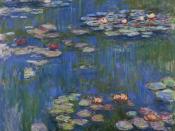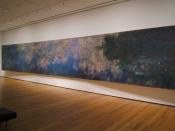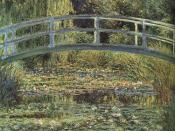For as long as I can remember, water lilies have always been a sign of peacefulness to me. This is one of the reasons I have always been drawn to Claude Monet's Bridge over the Water-lily Pond (1905). The green hues in this piece bring me a feeling of happiness. The Bridge over the Water-lily Pond has a sense of calmness and tranquility. There exists such expression and emotions from the impasto in this piece as well.
The foreground is filled with beautiful water lilies floating atop a peaceful pond. In the middle ground is the famous Japanese bridge with some green shrubbery. In the background there are tall droopy trees somewhat like willows.
Monet uses color to create his tranquil mood throughout the painting. He uses cool colors such as green and purple. He also uses black, brown, white, yellow, and pink. There utilizes his limitless color range. Monet's choice of colors is expressive and symbolic for the mood.
For example, the green emphasizes peacefulness and the yellow adds the warm calm feeling.
Texture is a significant element used in this piece. The piece shows the rough, thickness of the paint. Monet uses the effect of actual texture so, for example, if you were to go up and touch the painting you would be able to feel the impasto.
Another important element used in this piece is value/light within the atmosphere. There are highlights present on the pond, using white and yellow, where the light is shining. Also, there are shadows, using black and brown, where the trees are blocking the light.
It is apparent where the emphasis in this piece is centered. The bridge is the only one focal point in this painting. The lines from the trees and shrubbery lead your eye toward the center where the...


